The MGA With An Attitude
WEBER DGV Carburetor Installation - CB-308
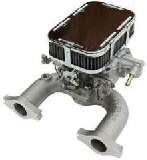 Occasionally you find a Weber two barrel downdraft carburetor on a matching intake manifold on an MGA or MGB (and other vintage British cars). This is generally functional (although a bit smaller than the original SU carbs), may give better starting and driveability with a slight loss of top end power and slightly worse fuel economy. This would usually be done in a prior life when the original carburetors might be worn out or missing, or when some misguided soul was convinced the the word "Weber" would make the car go faster (or at least be more impressive). I don't particularly like the Weber downdraft carburetor on an MG, but there are a lot of them around, and some problems with them, so I may be encouraged to post information occasionally.
Occasionally you find a Weber two barrel downdraft carburetor on a matching intake manifold on an MGA or MGB (and other vintage British cars). This is generally functional (although a bit smaller than the original SU carbs), may give better starting and driveability with a slight loss of top end power and slightly worse fuel economy. This would usually be done in a prior life when the original carburetors might be worn out or missing, or when some misguided soul was convinced the the word "Weber" would make the car go faster (or at least be more impressive). I don't particularly like the Weber downdraft carburetor on an MG, but there are a lot of them around, and some problems with them, so I may be encouraged to post information occasionally.
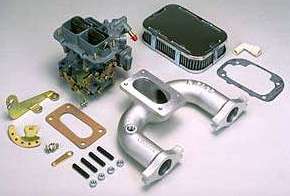

When installing the Weber downdraft carb on an MGA or early MGB (with draft pipe crankcase ventilation), the valve cover vent should be connected to the air cleaner (as originally done on these cars). For later production cars with Positive Crankcase Ventilation, the valve cover vent may be connected to the air cleaner, but only if you install a flow restrictor in the connecting pipe. PCV draws a significant vacuum in the crankcase, which would flow too much raw air into the intake manifold if there was no restrictor.
When installing the Weber downdraft carb in a later production car with Fuel Vapor Recovery and/or Anti-Run-On valve, the carburetor must be modified to retain these functions. The float chamber vertical vent to air cleaner needs to be plugged to seal the float chamber, and a float chamber side vent must be connected to enable vapor recovery and anti-run-on functions. This is covered in a following article.
These Weber carbs may sometimes be supplied as a kit specific to your particular car model, in which case there may be some model specific brackets and fittings, and possibly some model specific instructions. More often you just get a basic carburetor and an intake manifold that should bolt to the cylinder head, and from there you may be on your own to figure out how to get it hooked up to work, and there are a lot of pitfalls. It is bad enough that there will be insufficient instructions and parts, but there is fairly often some mis-instruction telling you how to do it wrong. The simple instruction to connect the crankcase vent to the air cleaner is often wrong for all but the early draft pipe vent set-ups. I will post a few tips here as time allows, and as questions may trickle in.
This tip comes from William Shivelle in Palm Coast, Florida, USA, who wrote:
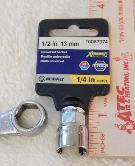 "Cut-a-way socket for Weber carb mount nuts (and other 1/2-inch nut/bolt access problems). After installing a Weber 34 DGEC carb kit on my 1959 1500 MGA, I kept having carb fuel leak and vacuum issues. It turns out that the 2 rear mount bolts were loose, but I could not tighten any more due to nut access. Finally I came across the Kobalt Universal Extreme dual size sockets. I bought the 1/2-in / 13-mm one that has a thru hole for bolts/studs and hex end for driving with wrench or socket.
"Cut-a-way socket for Weber carb mount nuts (and other 1/2-inch nut/bolt access problems). After installing a Weber 34 DGEC carb kit on my 1959 1500 MGA, I kept having carb fuel leak and vacuum issues. It turns out that the 2 rear mount bolts were loose, but I could not tighten any more due to nut access. Finally I came across the Kobalt Universal Extreme dual size sockets. I bought the 1/2-in / 13-mm one that has a thru hole for bolts/studs and hex end for driving with wrench or socket.
To be able to access the Weber 1/2" mounting bolt, I cut about 25% of the socket wall away, as nothing will fit between the nut and carb body. I used a cut-off disk on drill shaft mounted in a drill press. See photos. The socket is held in a vice for safety and accurate cut. First cut made the slots in the socket wall for the section to be removed. Second cut trims off the section at the base of socket area. File the edges as they are sharp. I painted cut surface for rust prevention.
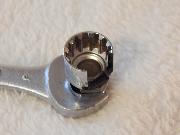
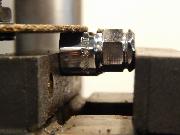
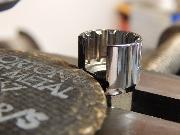
See photos for how the socket worked in this application. Socket goes over the nut and will turn the nut until socket wall hits carb body. Remove socket, rotate, repeat. With the hex end on the socket above the nut plane, a reasonably clear space is now available to use a 13mm spanner/wrench to turn the socket. Worked great, solved leaks issue. With the socket being 1/2" I can see many applications on British cars".


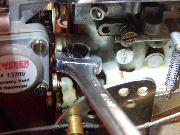
These carburetors occasionally need to replace the rubber diaphragm for the accelerator pump, hiding within the little square cover on the side with four screws. Service parts may be available from Pierce Manifolds in Gilroy, California, or Pegasus Auto Racing Supplies in New Berlin, Wisconsin. Some speed shops may also have access to parts for these carburetors. Otherwise these carb parts are not normally available from the common auto parts stores. They used to be very common in the 1960's and 1970's, not so much after 1980.
|